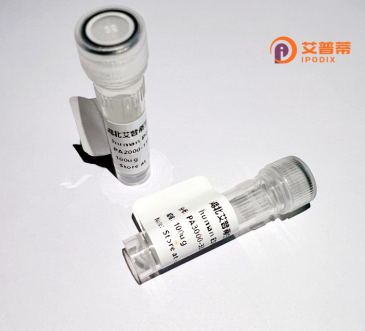
| 纯度 | >90%SDS-PAGE. |
| 种属 | Human |
| 靶点 | USP13 |
| Uniprot No | Q92995 |
| 内毒素 | < 0.01EU/μg |
| 表达宿主 | E.coli |
| 表达区间 | 1-863 aa |
| 活性数据 | MQRRGALFGMPGGSGGRKMAAGDIGELLVPHMPTIRVPRSGDRVYKNECAFSYDSPNSEGGLYVCMNTFLAFGREHVERHFRKTGQSVYMHLKRHVREKVRGASGGALPKRRNSKIFLDLDTDDDLNSDDYEYEDEAKLVIFPDHYEIALPNIEELPALVTIACDAVLSSKSPYRKQDPDTWENELPVSKYANNLTQLDNGVRIPPSGWKCARCDLRENLWLNLTDGSVLCGKWFFDSSGGNGHALEHYRDMGYPLAVKLGTITPDGADVYSFQEEEPVLDPHLAKHLAHFGIDMLHMHGPENGLQDNDIKLRVSEWEVIQESGTKLKPMYGPGYTGLKNLGNSCYLSSVMQAIFSIPEFQRAYVGNLPRIFDYSPLDPTQDFNTQMTKLGHGLLSGQYSKPPVKSELIEQVMKEEHKPQQNGISPRMFKAFVSKSHPEFSSNRQQDAQEFFLHLVNLVERNRIGSENPSDVFRFLVEERIQCCQTRKVRYAERVDYLMQLPVAMEAATNKDELIAYELTRREAEANRRPLPELVRAKIPFSACLQAFSEPENVDGFWSSALQAKSAGVKTSRFASFPEYLVVQIKKFTFGLDWVPKKFDVSIDMPDLLDINHLRARGLQPGEEELPDISPPIVIPDDSKDCLMNQLIDPSDIDESSVMQLAEMGFPLEACRKAVYFTGNMGAEVAFNWIIVHMEEPDFAEPLTMPGYGGAASAGASVFGASGLDNQPPEEIVAIITSMGFQRNQAIQALRATNNNLERALDWIFSHPEFEEDSDFVIEMENNANANIISEAKPEGPRVKDGSGTYELFAFISHMGTSTMSGHYICHIKKEGRWVIYNDHKVCASERPPKDLGYMYFYRRIPS |
| 分子量 | 121.44 kDa |
| 蛋白标签 | GST-tag at N-terminal |
| 缓冲液 | PBS, pH7.4, containing 0.01% SKL, 1mM DTT, 5% Trehalose and Proclin300. |
| 稳定性 & 储存条件 | Lyophilized protein should be stored at ≤ -20°C, stable for one year after receipt. Reconstituted protein solution can be stored at 2-8°C for 2-7 days. Aliquots of reconstituted samples are stable at ≤ -20°C for 3 months. |
| 复溶 | Always centrifuge tubes before opening.Do not mix by vortex or pipetting. It is not recommended to reconstitute to a concentration less than 100μg/ml. Dissolve the lyophilized protein in distilled water. Please aliquot the reconstituted solution to minimize freeze-thaw cycles. |
以下是关于重组人USP13蛋白的3篇参考文献示例及简要内容概括:
1. **"USP13 regulates autophagy by deubiquitinating Beclin1 in cancer progression"**
- **作者**: Liu, J. et al.
- **摘要**: 本研究揭示了USP13通过去泛素化自噬关键蛋白Beclin1调控自噬活性,促进肿瘤细胞的存活。重组人USP13蛋白被用于体外酶活实验,证实其直接作用于Beclin1并增强自噬通量。
2. **"Structural and functional analysis of USP13 reveals a role in stabilizing oncogenic EGFRvIII in glioblastoma"**
- **作者**: Wang, Y. et al.
- **摘要**: 文章解析了重组人USP13蛋白的晶体结构,并发现其通过去泛素化稳定胶质母细胞瘤中的突变型EGFRvIII,促进肿瘤生长,为靶向USP13的癌症治疗提供依据。
3. **"A high-throughput screen identifies USP13 as a novel regulator of the Parkinson’s disease-linked protein Parkin"**
- **作者**: Yuan, Y.C. et al.
- **摘要**: 通过高通量筛选,本研究证实重组USP13蛋白直接与Parkin相互作用,调控其稳定性及线粒体自噬功能,提示USP13在帕金森病中的潜在作用。
4. **"Development of a recombinant USP13 activity assay for drug discovery in neurodegenerative diseases"**
- **作者**: Almaliti, J. et al.
- **摘要**: 该研究建立了一种基于重组人USP13蛋白的体外酶活检测体系,用于筛选小分子抑制剂,为治疗阿尔茨海默病等神经退行性疾病提供了新工具。
以上文献涵盖了USP13在癌症、自噬、神经疾病等领域的功能机制及重组蛋白的应用(如结构解析、酶活分析),可作为相关研究的参考。
**Background of Recombinant Human USP13 Protein**
Ubiquitin-specific protease 13 (USP13) is a member of the ubiquitin-specific protease (USP) family, a class of deubiquitinating enzymes (DUBs) critical for regulating protein stability and turnover by removing ubiquitin moieties from target proteins. USP13 plays a multifaceted role in cellular processes, including protein quality control, DNA repair, autophagy, and immune response regulation. Structurally, it contains conserved USP domains responsible for catalytic activity and additional regulatory domains that influence substrate specificity.
USP13 has garnered attention for its involvement in diseases, particularly cancer and neurodegenerative disorders. It modulates key signaling pathways, such as the p53 and PTEN pathways, by stabilizing oncoproteins or tumor suppressors. For example, USP13 stabilizes MITF in melanoma and deubiquitinates BRCA1 to promote DNA repair in breast cancer. Conversely, its dysregulation has been linked to pathological aggregation of proteins like α-synuclein in Parkinson’s disease.
Recombinant human USP13 protein is produced via heterologous expression systems (e.g., *E. coli* or mammalian cells) for functional studies. It enables mechanistic exploration of USP13’s enzymatic activity, substrate interactions, and regulatory roles. Researchers leverage purified USP13 to screen inhibitors or study post-translational modifications, aiming to develop therapeutic strategies targeting USP13-associated diseases. Despite progress, USP13’s context-dependent functions and substrate diversity remain areas of active investigation, highlighting its complexity as a therapeutic target.
×